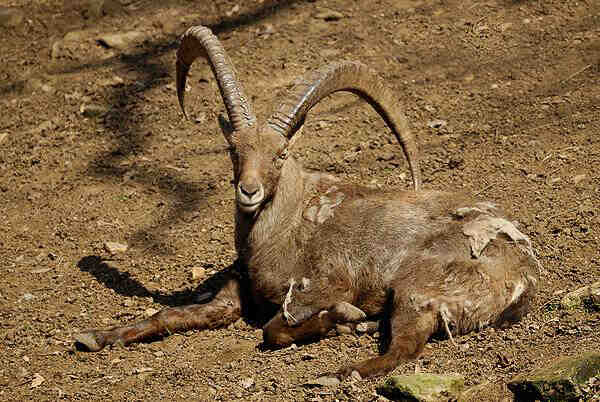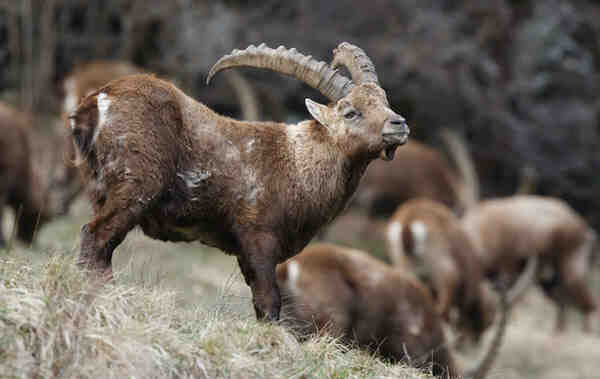Capra ibex
IUCN
LCBasic Information
Scientific classification
- name:Capra ibex
- Scientific Name:Ibex, Alpine Ibex, Capra Ibex, Alpine Ibex
- Outline:Ungulata
- Family:Artiodactyla Bovidae Capra
Vital signs
- length:121-141cm
- Weight:30-100kg
- lifetime:About 19 years
Feature
They use their horns to protect themselves from predators.
Distribution and Habitat
Origin: Italy.
Re-introduction: Austria, France, Germany, Switzerland. Also found in Bulgaria and Slovenia in the 21st century.
The ibex is a wild goat of the genus Capra, found in the mountains. It is a typical alpine animal with superb climbing skills, able to climb the most dangerous cliffs. The ibex lives among the rocks on the snow-capped Alps in Europe, and is mainly found in steep and rugged terrain between 1600-3200 meters above sea level, although some populations may be found living as low as 700-800 meters above sea level.
Appearance
Ibex, male body length 1.3-1.4 meters; shoulder height 65-105 cm; weight 80-100 kg; female body length 121-141 cm; shoulder height 65-70 cm; weight 30-80 kg. Male horns are 69-98 cm long, and female horns are 18-35 cm long. Male ibexes can generally grow to 1 meter tall and weigh 100 kg, and female ibexes are usually half the size of males. In addition to body size, the biggest difference between males and females is the conspicuous beard. Both male and female ibexes have large, backward-curved horns, and the male's horns can grow up to 1 meter long, and the longest is 1.47 meters. They use their horns to protect themselves from predators such as wolves, lynxes, bears, jackals, and foxes. Young ibexes are also at risk of attacks from large birds such as eagles. Ibex are brownish-grey in the summer and dark brown in the winter. Only males have beards. Both males and females have backward-curving horns.
Details
Ibex (scientific name: Capra ibex) English Alpine ibex, French Bouquetin des Alpes, Spanish Íbice de los Alpes, German Alpensteinbock, Italian Stambecco alpino, no subspecies.

Ibex are herbivores and feed on grass, moss, flowers, leaves and twigs. If leaves and twigs are beyond their reach, ibexes will stand on their hind legs to eat these foods. They feed during the dusk and evening hours, starting from the high steep cliffs to the lower Alpine meadows. The rest of the time they stay on higher cliffs and slopes to avoid predators. In winter, due to the scarcity of food, ibexes tend to live at lower altitudes. In summer, since they need to drink water every few days, they choose to live near water sources.
Male ibexes usually live in groups in summer. During the estrus period in late autumn, male ibexes will leave the group and look for female ibexes alone. During the breeding season, male ibexes will fight each other to determine who will mate with the female. In addition to butting each other with their horns, they rarely actually hurt each other. Natural enemies include wolves, lynx, bears, jackals and foxes. Young ibexes may also face attacks from large birds such as eagles.

The mating system of ibexes is one male and multiple females. The winner of a fierce battle with other males joins a group of females in December. The winner of the battle gets the right to breed with a group of 10-20 females. The mating season is from December to January, and the gestation period is about 147-180 days. After a gestation period of 6 months, the young ibex will be born in about May. Each litter has 1-2 babies, and the incidence of 2 babies is about 20%. On the first day after giving birth, the young ibex can follow the mother on the rocky cliffs. Sexual maturity period is 8-12 months. But it will not reproduce until 2 or 3 years old. The life span of wild ibex is about 19 years.
The ibex has been considered a mysterious animal for a long time. Almost all parts of its body, even its excrement, are used as ingredients in magic medicines to treat different diseases. Therefore, the ibex was once hunted in large numbers and was close to extinction in the early 19th century. But thanks to forestry workers, the ibex in Gran Paradiso was finally protected in 1816. In 1854, King Vittorio Emanuele II of Italy provided protection for the ibex. After many large-scale reintroduction programs, the number of ibexes is estimated to be 30,000, and the conservation status is Least Concern.
Listed in the IUCN Red List of Threatened Species in 2020 ver3.1 - Least Concern (LC).
Protect wildlife and eliminate game.
Maintaining ecological balance is everyone's responsibility!








